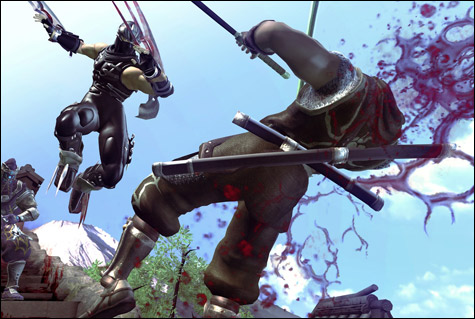
THROWBACK: Remember when a game really was “just a game”? |
To judge by the way they’re portrayed in video games, ninjas are suffering from an identity crisis. Sometimes, as in the Tenchu series, their watchword is stealth. They hide in the shadows, becoming one with the night, and engage their enemies only when absolutely necessary. Then we have Ninja Gaiden II, whose protagonist, Ryu Hayabusa, is a whirling dervish of destruction, charging into crowds of foes and leaving piles of body parts in his wake. As a sequel to the successful Ninja Gaiden on the original Xbox, Ninja Gaiden II comes with few surprises. Like its forebear, it features slick graphics, lightning-fast gameplay, and more than a few glaring flaws.
More so than many games, Ninja Gaiden II seems to revel in the æsthetic possibilities of bloodshed. As Ryu pummels his opponents, they begin to lose limbs, but they keep right on attacking. It’s silly at first, and almost as funny as King Arthur’s battle against the Black Knight in Monty Python and the Holy Grail. But that’s not all: once maimed, enemies can be obliterated in particularly gruesome, cinematic fashion. The violence is so amped up that it quickly plummets from hilarious to tiresome. It’s brilliantly rendered, sure, but how many times can you watch the same beheading animation before it gets old?
The game does make you earn those obliterations. Although Ryu takes on crowds of opponents at once, they don’t hang back and attack him one by one, the way they do in classic ninja movies. Which means that evasion and defense are key to winning battles. A counterattack move, which can be triggered only at a precise moment after blocking an enemy’s strike, is a difficult but necessary technique to master. Powerful magical attacks require the expenditure of precious resources. The game’s insistence on skill and timing, even on the lower difficulty levels, makes it more than just a gorefest. It’s anything but a button masher. There’s a real sense of accomplishment to progressing through it.
Which is not to give the impression that I progressed all the way through it. Team Ninja is listing an easier difficulty level than was available in the first Ninja Gaiden, though some of the boss battles would seem to belie this claim. In the 8-bit tradition, Ninja Gaiden II’s bosses hit you with devastating, pattern-based attacks and can sometimes wipe you out in one blow. And it’s here that the capricious game camera becomes a serious problem. You can’t choose to lock onto a foe and keep him in your field of view at all times. The camera, for reasons known only to it, has a habit of quickly cutting behind Ryu, even if that means forcing you to lose sight of threats. Difficulty is one thing, but it should at least be fair.
Still, there’s a certain class of gamer that thrives on these sorts of challenges. It’s not impossible to cope with the camera. And Ninja Gaiden II is about as finely honed an experience as you’ll find these days. Most games are attempting greater environmental interaction, more play modes, and deeper story lines; Ninja Gaiden II is, for better and worse, a throwback to classic games in which all that mattered was clearing levels of successively tougher enemies — to a time when a game really was “just a game.” On those terms, it’s success.